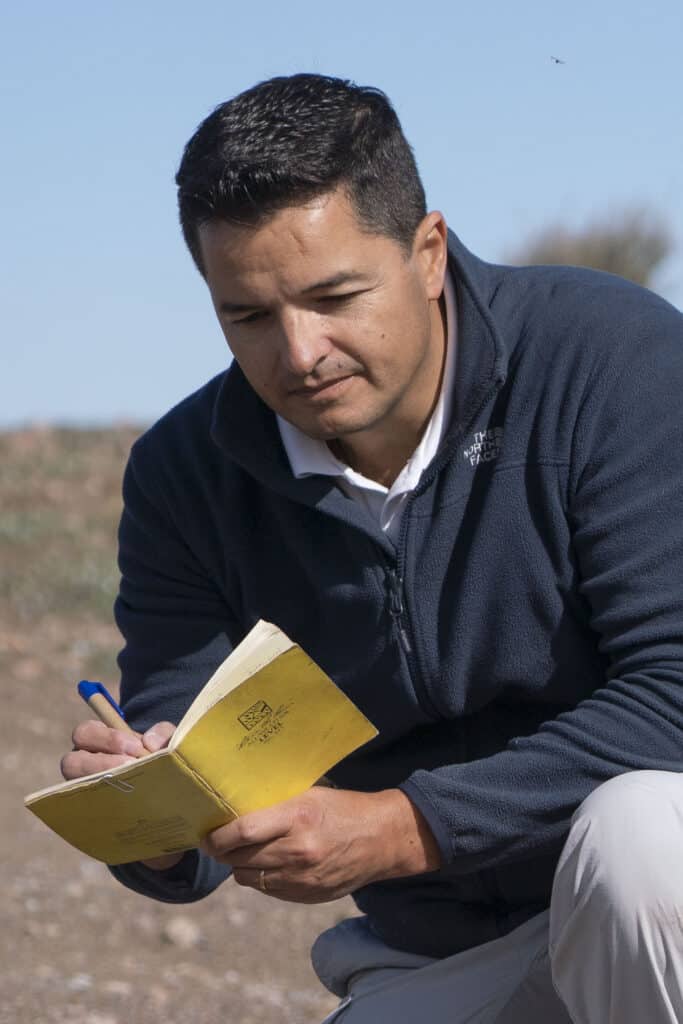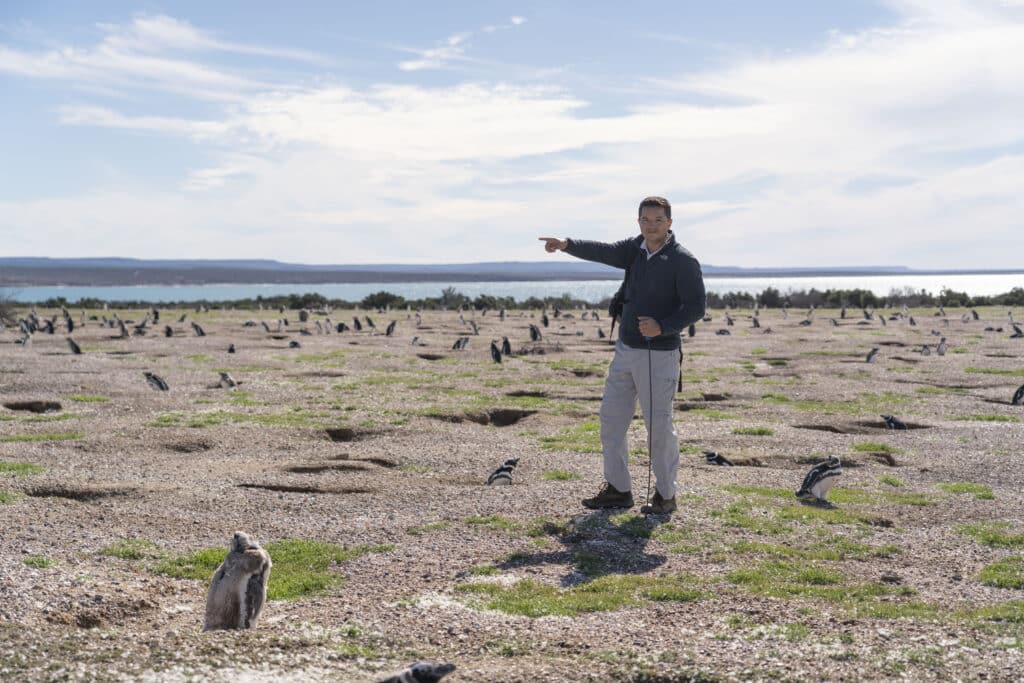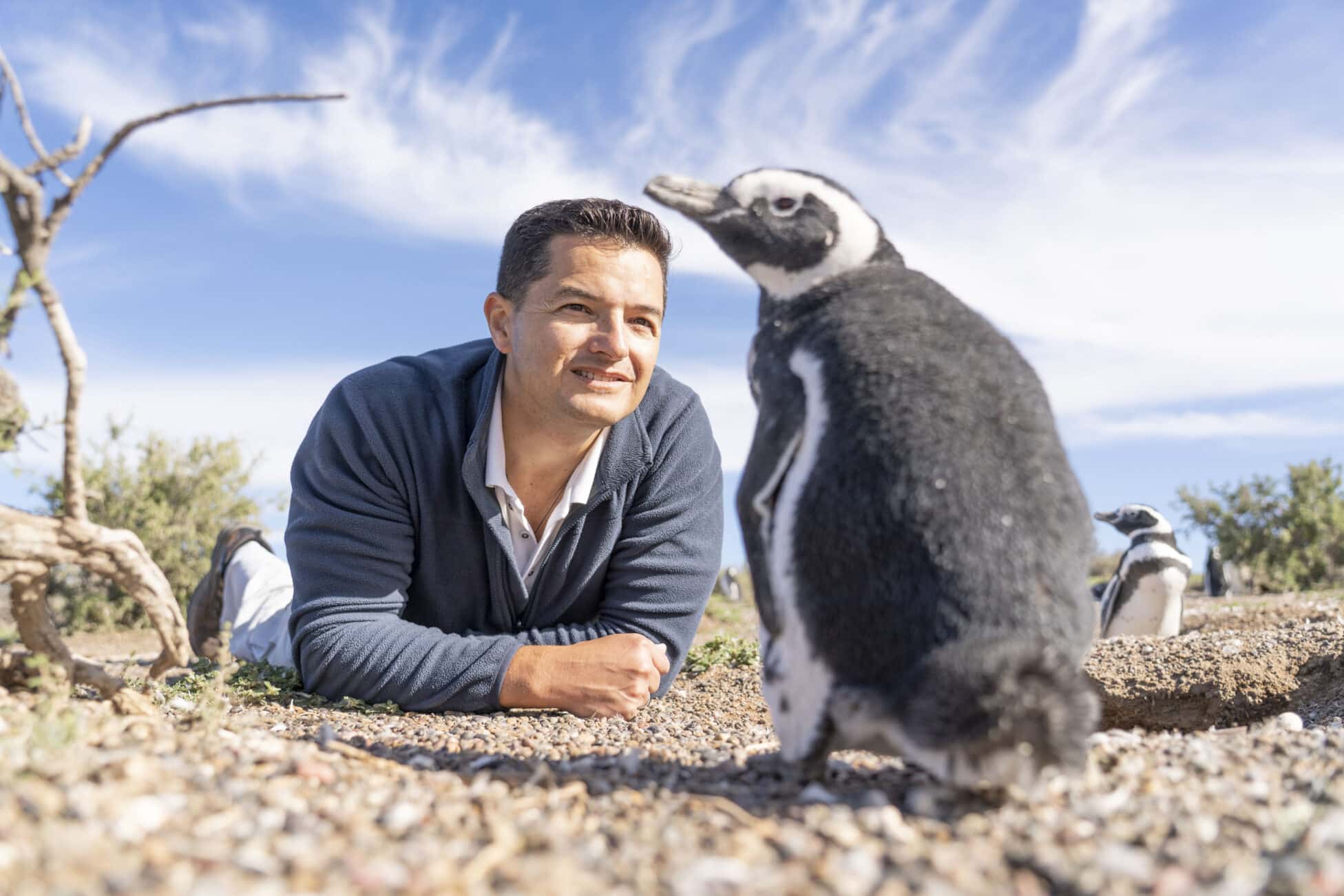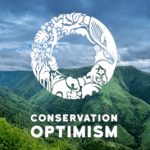Have you ever wondered how conservationists spend their days or what keeps them optimistic about the future of nature? Do they always spend their time in the distant wild, or might they be hidden all around us? Do their roles encompass aspects we never thought of?
“Meet The Optimists” is a monthly blog series by Conservation Optimism which introduces conservationists working in different fields and contexts to our readers. We discuss their journeys into conservation, typical daily activities and reasons for hope.
Read on for the inside story on different careers and fresh approaches to conservation!
In the June 2023 blog of Conservation Optimism’s “Meet The Optimists” series, Dr Pablo Borboroglu shares what it is like to be researching penguins, work for their conservation and his optimism for their survival!

Dr Pablo Borboroglu
Pablo Borboroglu, mostly known as Popi, is a penguin researcher and conservationist. He is the founder and president of the Global Penguin Society, as well as a researcher at the National Research Council in Argentina, an associate professor at the University of Washington, and the co-founder and co-chair of the IUCN Penguin Specialist Group. He is a Whitley Award winner who has spent 34 years in the field of marine conservation, focusing on protected areas and seabird ecology and conservation, with special emphasis on penguins. He also works on marine conservation tools planning and implementation and in education, interacting with government agencies, communities, and multiple institutions. For example, he leads processes to help designate, plan and implement marine and terrestrial protected areas.
Can you trace the origins of your interest in conservation and what led to your current work?
My interest in conservation can be traced back to my early childhood. When I was about three years old, my grandmother used to tell me fascinating stories about her visits to see the penguins in Patagonia over 100 years ago, and those stories ignited a sense of wonder and magic within me. Her passionate descriptions of the penguin colonies left a lasting impression on me.
As I grew into adolescence, I developed a desire to become an ambassador. Therefore, I studied languages (English and French) and law for two years, but I didn’t find them particularly fulfilling. It was during this time that I decided to spend a summer in Patagonia, and I began working at a travel agency.
During the 1980s, it was common to find a significant number of penguins covered in oil on the beaches. Around 40,000 penguins were dying annually due to pollution. Witnessing this heartbreaking issue had a profound impact on me. I started rescuing oil-covered penguins and established an emergency station. Working as a tour guide for foreign visitors, I learned extensively about wildlife, particularly penguins, and I realised that I could convey a message of conservation to a larger audience. Later on, in 1991, an oil spill killed 17,000 penguins in two months, and after huge rehabilitation efforts, I had one important moment when I was releasing one penguin back into the ocean and thought to myself, ‘If I can make this small effort and have such a big impact on this penguin population, what happens if I dedicate my life to this? I can replicate this on a larger scale.’ But to do so, I needed to educate myself to be more helpful to penguins.
Motivated by these realisations, I decided to study biology at university and later pursued a PhD in ecology, focusing on the management and conservation of marine birds. Throughout these stages of my academic journey, I continued to work on scientific research and conservation efforts specifically aimed at protecting penguins.
After some years, I created the Global Penguin Society, which is an international organisation that promotes the protection of 18 species of penguins through guided action.
What does a typical day of work look like for you?
Within the year, my life is divided into two periods, with or without penguins in their colonies. When penguins are breeding, we spend a lot of time in the field in very remote places. Typically we leave our city very early in the morning and drive long distances to reach the penguin colonies where we work.
In terms of science, we conduct our own projects, work in collaboration with partners and support other species’ projects worldwide. Argentina, New Zealand and Chile are some of our main research areas. Depending on the research activity, our team size can be large or small. When we census penguin colonies, we typically work in large groups because we survey whole colonies, which can have an area of up to 400 hectares in some cases. We also check nests to determine the colony breeding performance. These censuses demand a lot of effort and resources, particularly when we require marine logistics to work on islands with penguin colonies.
Other work includes deploying tracking devices on penguins to identify their feeding or migrations routes, allowing us to detect overlaps with harmful human activities. This data is instrumental in proposing and designing marine protected areas and elaborating management plans for specific human activities such as fisheries, oil developments, etc. In terms of Education, we both involve and empower local and global communities and reach decision-makers. One of our key actions is school trips, where we target local education efforts in communities and schools near penguin colonies, so the next generation will value penguins better. We organise trips for children to visit penguins in their natural areas, give talks and donate hundreds of books on wildlife and conservation. So far, almost 8,000 children have benefited from this activity and reached about 200,000 with our entire program..
Beach and Penguin Colonies clean-up are also key actions: Penguin colonies often become littered with trash left by commercial boats and beach-goers. Every year, before penguins arrive from their annual winter migration, we engage local teenagers in beach clean-up activities. Since much of the trash is plastic, this gives us an opportunity to draw attention to the problem of single-use plastics and ocean pollution.
Another dimension of our work is to work closely with governments, communities and landowners to generate effective conservation policies to benefit penguins, their ecosystems and nearby communities. One key goal of this work is to create new marine and coastal protected areas and to improve the management of existing ones to protect penguin foraging and breeding grounds.

Dr Pablo Borboroglu
What is your favourite and least favourite aspect about your role?
Favourite Aspect: I find great joy and fulfilment in working directly with these amazing and fascinating birds. Observing penguins in their natural habitats and contributing to their well-being is incredibly rewarding. Every day, I feel incredibly grateful for the opportunity to contribute to the preservation of penguins, their habitats, and the broader marine ecosystem. Witnessing positive outcomes, such as successful breeding seasons or population recoveries, are particularly gratifying. I also love to join our school trips, where we take children from developing countries to visit penguin colonies for the first time in their lives, even when living 30 minutes away from them.
Least Favourite Aspect: On the other hand, as penguin conservationists, sometimes we face challenges and frustrations in our work. Conservation efforts often involve dealing with various obstacles, such as habitat degradation, fisheries, climate change impacts, human disturbance, and plastic or oil pollution. Witnessing the negative effects of these factors on penguin populations and their habitats can be disheartening. Additionally, we face political constraints and bureaucratic hurdles, which can make our work more challenging. The constant need for advocacy, education, and community engagement can be demanding but is crucial for achieving long-term conservation goals.
As a conservationist, what makes you hopeful about the future?
There are several factors that give me hope for the future as a conservationist. One significant reason is the inherent conservation mindset found in younger generations. I find great encouragement in witnessing how the younger population, including my own sons, incorporate environmental considerations into their daily lives, even if they pursue careers outside of biology. They understand the importance of protecting the environment and incorporate it into their decision-making processes. This generational shift is particularly promising because, in the near future, they will comprise the majority of the global population, leading to potentially widespread environmental consciousness and action.
Another source of hope for me stems from the advancements in technology. New inventions and innovations not only help address the problems we have created in the past but also offer potential solutions to prevent future challenges. Technology has played a significant role in conservation efforts by providing tools and techniques to mitigate environmental issues. For instance, the development of remote sensing technologies enables us to monitor and manage ecosystems on a larger scale. We can now gather valuable data allowing us to make more informed decisions and take targeted conservation actions. Additionally, emerging technologies such as artificial intelligence, machine learning, and big data analytics hold immense potential for conservation. They enhance our ability to analyse vast amounts of information, identify patterns, and predict ecological trends. This knowledge can guide us in implementing proactive conservation strategies and optimising resource allocation. Furthermore, innovative solutions are being developed to address specific challenges. For instance, renewable energy technologies offer sustainable alternatives to fossil fuels, reducing carbon emissions and mitigating climate change. Advanced waste management systems and recycling technologies are helping us tackle the issue of pollution and waste accumulation. The continuous progress and evolution of technology provide hope that we can find effective and efficient ways to preserve and protect our environment. By embracing these advancements and integrating them into our conservation efforts, we can create a future where technology acts as a powerful ally in our mission to safeguard the planet.
It’s important to note that technology alone cannot solve all our environmental problems. It must be accompanied by a shift in mindset, policy changes, and collective action. However, the potential of technology to drive positive change and support conservation initiatives is undoubtedly a cause for optimism in shaping a more sustainable future.

What helps you stay positive day-to-day?
One of the main sources of inspiration that helps me stay positive on a daily basis is observing penguins. Penguins embody traits of bravery, determination, and resilience. Their unwavering focus on their singular goal of producing and protecting their chicks is truly remarkable.
Consider the incredible journey of a Magellanic penguin. Swimming up to 10,000 miles per year, they can live for up to 35 years, covering the equivalent of circumnavigating the planet 12 times during their lifetime. Despite the challenges they face, penguins remain steadfast in their pursuit. They remind us that even in the harshest conditions, we can overcome obstacles and emerge stronger.
The unwavering determination of penguins serves as a powerful reminder that we, too, can persevere in the face of adversity. Witnessing their resilience and ability to thrive amidst challenging circumstances instils hope and optimism in me.
Additionally, the connection I feel with penguins has a personal and emotional element. Being surrounded by penguins helps me tap into cherished memories of my grandmother, who ignited my passion for conservation. In times of crucial decision-making, being in their presence brings me a sense of clarity and connection, as if I am channelling her wisdom and guidance.
In addition to penguins, other practices and sources of inspiration can help maintain positivity in our own lives. Moreover, seeking out positive stories of environmental progress and conservation successes can provide a much-needed dose of inspiration. Celebrating the accomplishments of individuals, organisations, and communities dedicated to protecting the planet can remind us of the collective power we possess to make a difference.
Ultimately, staying positive day-to-day requires finding sources of inspiration that resonate with our own values and experiences. By drawing upon the strength and determination of penguins, connecting with personal memories, and embracing practices that promote well-being, we can cultivate optimism and resilience in our own lives and inspire others to do the same.
Could you share a story about a formative moment in your conservation career?
When we discovered the first penguins settling down in El Pedral colony in Argentina 15 years ago, the landscape was far from idyllic. Trash littered the area, dogs harassed the fledgling penguin colony, and people used to hunt and even burned bushes close to their nests to make barbecues. Amidst this challenging environment, there was one determined penguin named Clarita who would become a symbol of resilience and hope.
Clarita, a Magellanic penguin, earned the endearing title of “mother of Pedral” as she successfully hatched the first chick in the colony. I could see with my own eyes when that first chick broke the eggshell and hatched from his egg. However, her nesting situation was far from ideal. Sharing her nest with a large plastic soda bottle, Clarita exemplified the harsh reality that the penguins faced in their struggle for survival.
But the tide began to turn when our work through the Global Penguin Society (GPS) stepped in, collaborating with the local government and landowners to transform El Pedral into a protected wildlife refuge. Our efforts, including ongoing conservation initiatives and educational and community engagement programs, yielded remarkable results. Today, El Pedral stands as a testament to the power of conservation. Its once-troubled coastline has blossomed into a stunning and secluded haven, proudly hosting an impressive 8,100 penguins. Thanks to our efforts, El Pedral now thrives not only as a sanctuary for wildlife but also as a hub for eco-tourism, bringing sustainable income to the region while safeguarding the penguin colony. Throughout this transformative journey, Clarita remains a symbol of perseverance, and the profound impact that focused conservation efforts can achieve. Her story echoes our commitment to protect and preserve penguins, showcasing the positive outcomes that can emerge from conservation efforts.
This formative moment in my conservation career serves as a vivid reminder that even in the face of adversity, resilience and collective action can bring about remarkable change. The story of Clarita and the El Pedral colony inspires us to continue striving for a world where nature thrives and the beauty of wildlife endures for generations to come.
Any advice for someone interested in pursuing your field of work?
My advice for someone interested in pursuing a career in conservation is to follow your dreams and your passion. If you have a genuine love for the environment, don’t hesitate to go for it. Remember that you can contribute to conservation even if you pursue careers that are not directly related to biology. There is a need for economists, sociologists, social psychologists, environmental lawyers, engineers, and individuals with various skills to provide solutions to our unsustainable way of living. Embrace interdisciplinary learning and gain practical experience through internships, volunteer work, or research projects.
Collaboration and building connections are key, as conservation is a collective effort involving various stakeholders. Be determined, adaptable, and open to learning. Pursuing a career in conservation can be both rewarding and challenging, but your passion and dedication can make a significant impact in building a more sustainable future.


